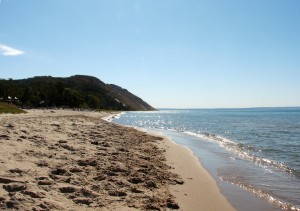By Sarah Coefield and Kimberly Hirai
Jan. 26, 2010

In the Great Lakes, the area closest to shore is often the least understood. Photo by Sarah Coefield
Editor’s note: This is the first in a series of stories on how new technology is giving researchers a glimpse of the critical nearshore area of the Great Lakes.
Little is known about the currents, fish or bottom of the nearshore area of the Great Lakes.
Now, technology is providing researchers a window into what is one of the most productive yet least studied areas of the Lakes.
The nearshore stretches from the beach into about 30 feet of water.
Despite its proximity to land, researchers have long focused on more distant waters.
Nearshore Navigators
Scientists typically study areas far from shore because the data collection is simpler, said John Gannon, a senior scientist with the International Joint Commission, a U.S./Canadian body that advises the governments on boundary water issues. In the nearshore areas “you can take a sample one minute and 10 minutes later you’re dealing with a different water mass … those kinds of high variability kind of scared them,” he said.
New technologies, such as a swimming video camera and an all-terrain robot, are granting researchers their first glimpse of a region critical to the Great Lakes’ health.
The nearshore “serves as both a buffer and a link between upland and terrestrial habitats and the open waters, offshore areas of the lake,” said Jim McKenna, a research ecologist with the U.S. Geological Survey Great Lakes Science Center and Tunison Laboratory of Aquatic Sciences. Contaminants and nutrients in the Great Lakes pass through the nearshore before reaching deeper waters. As a result, the nearshore area can be the first to show impacts or degradation.
“It’s where the changes to the lakes first appear and when things improve it’s where it’s first to show up as well,” said Jan Ciborowski, a professor in the department of biological sciences at the University of Windsor in Windsor, Ontario.
“When the zebra mussels arrive that’s where they seem to be. When we get algal blooms washing up on shore it’s the nearshore that we’re worried about,” Ciborowski said.
For researchers investigating Great Lakes phenomena such as the resurging algal blooms, new techniques are providing new tools, Gannon said. “And they’re very excited to apply them.”
Tomorrow: Triaxus uses sound and sensors to reveal sunken ships and data treasures